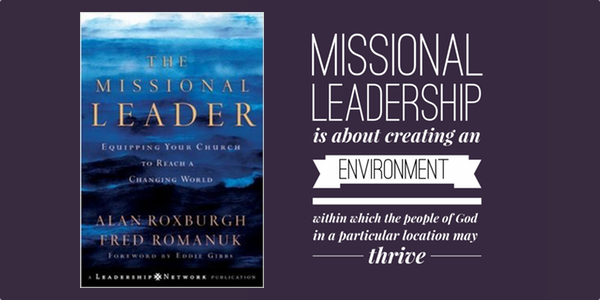In their book The Missional Leader: Equipping Your Church to Reach a Changing World authors Alan Roxburgh and Fred Romanuk state that “discontinuous change” is the defining feature of the environment where church leadership takes place. Such change requires new, rather than simply adjusted, forms of leadership. The book describes the course a church takes as it navigates change, and describes the type of leadership that such change requires.
Part One: The Context and Challenge of Missional Leadership
Part One opens with an overview of the issues at hand and a description of how Missional Leadership compares to pastoral leadership. They argue that God is not finished with the church, it his means of reaching the world. They explain the different phases of transition that a church will go through as it navigates from the models that served it well in the past to a missional model. The authors also describe what makes a missional congregation different, and why leading it is a unique task.
Part Two: The Missional Leader
Part Two focuses on descriptions of what makes a good leader including features like maturity and self-awareness. It also discusses how to create a coalition that will help build momentum in a missional direction. This requires creating a culture where the leadership listens to the church and the church listens to the surrounding community.
Quotes
“Missional leadership is about creating and environment within which the people of God in a particular location may thrive.”
“Today, in discussion about the nature of church leadership, there is little theological wrestling with the questions of how to form or socialize a people into an alternative community. On the contrary, there is growing emphasis on how to help seekers feel they belong in a congregation without any expectations or demands on their lives.”
“A missional church is a community of God’s people who live into the imagination that they are, by their very nature, God’s missionary people living as a demonstration of what God plans to do in and for all of creation in Jesus Christ.”
“We have forgotten that God’s future often emerges in the most inauspicious places. If we let our imagination be informed by this realization, it will be obvious that we need to lead in ways that are different from those of a CEO, an entrepreneur, a super leader with a wonderful plan for the congregation’s life. Instead, we need leaders with the capacity to cultivate an environment that releases the missional imagination of the people of God.”
“We are in a period that makes it impossible to have much clarity about the future and how it is going to be shaped. Therefore those leaders who believe they can address the kind of change we are facing by simply defining a future that people want, and then setting plans to achieve it, are not innovating a missional congregation. They are only finding new ways of preventing a congregation from facing the discontinuous change it confronts.”
Two Takeaways
One great takeaway is the “Three Zone Model of Missional Leadership.” It is a great tool for helping leaders of established churches comprehend the changes that must be made for a church to envision and carry out any new endeavor (not just “missional” ones.) Reading this, I began to see where various churches I have been a part of fit on the spectrum. It also helped me understand the difficulties many church leaders I interact with are having. Most importantly, it gave me a vision of what pitfalls to watch out for as my church matures.
Another valuable takeaway from the book is the interplay between the personality and the strengths of the leader and the nature of the congregation. The book seems clearly written to the average dwindling mainline church, whose leadership has been chosen for their ability to maintain the status quo. This is why the author’s discussion of “imagination” is valuable. It seems there are two ways to move forward: either start over with new leadership and a new endeavor or cultivate imagination. They rightly point the leaders toward remembering what God wants to do in the world, and who their neighbor is.
This to me is the most important lesson from the book: Missional Leadership must be relentlessly focused on the context of their congregation and personally entrenched in lives of those they are hoping to reach.
A church or a leader will never be missional if they haven’t met those to whom they are sent.










 Tweets
Tweets